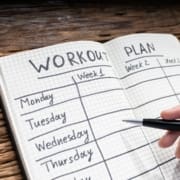Launching Into Marathon Training: Setting Your Plan in Motion
 Embarking on marathon training is an exciting journey that requires commitment, planning, and a dash of courage. Whether you’re a first-timer or a seasoned runner aiming for a new personal best, setting your plan in motion is the first step toward crossing that finish line. Here’s how to get started on the right foot.
Embarking on marathon training is an exciting journey that requires commitment, planning, and a dash of courage. Whether you’re a first-timer or a seasoned runner aiming for a new personal best, setting your plan in motion is the first step toward crossing that finish line. Here’s how to get started on the right foot.
1. Define Your Why
Before lacing up your shoes, take a moment to reflect on your motivation. Are you running for a cause, personal achievement, or simply to challenge yourself? Knowing your “why” will keep you focused and inspired throughout your training.
 2. Choose the Right Training Plan
2. Choose the Right Training Plan
Not all marathon training plans are created equal. Consider your current fitness level, running experience, and available time. Beginners might opt for a 16- to 20-week plan with gradual mileage increases, while experienced runners may choose a more advanced schedule. Look for plans that balance long runs, speed work, rest days, and cross-training.
 3. Set Realistic Goals
3. Set Realistic Goals
Set both process and outcome goals. Process goals could include sticking to your weekly mileage or completing every scheduled workout. Outcome goals might be finishing the marathon, achieving a specific time, or simply enjoying the experience. Make your goals specific, measurable, and attainable.
 4. Gather Your Gear
4. Gather Your Gear
Invest in a good pair of running shoes suited to your gait and foot type. Comfortable clothing, moisture-wicking socks, and a reliable watch or fitness tracker can make training more enjoyable. Don’t forget essentials like a water bottle, hat, and sunscreen.
5. Map Out Your Schedule
Consistency is key. Block out time in your calendar for runs, strength training, and recovery. If possible, find a running group or training partner for added motivation and accountability.
 6. Listen to Your Body
6. Listen to Your Body
Pay attention to how you feel during and after workouts. Rest and recovery are just as important as the miles you log. If you experience pain or fatigue, don’t hesitate to adjust your plan or seek advice from a coach or medical professional.
 7. Track Your Progress
7. Track Your Progress
Keep a training log to monitor your runs, note how you feel, and celebrate milestones along the way. Tracking progress helps you stay motivated and spot patterns that can inform future training.
8. Stay Flexible
Life happens—work, family, and unexpected events can disrupt your schedule. Adapt your plan as needed and remember that missing a workout or two won’t derail your marathon dreams.
Launching into marathon training is about more than just running; it’s about setting a foundation for success. With a clear plan, the right mindset, and a commitment to your goals, you’ll be well on your way to marathon day. Lace up, trust the process, and enjoy the journey!


 2. Choose the Right Training Plan
2. Choose the Right Training Plan 3. Set Realistic Goals
3. Set Realistic Goals 4. Gather Your Gear
4. Gather Your Gear
 6. Listen to Your Body
6. Listen to Your Body 7. Track Your Progress
7. Track Your Progress



